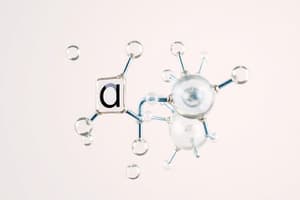Podcast
Questions and Answers
What are the alkali metals known for?
What are the alkali metals known for?
- Two loosely bound valence electrons
- Complete valence electron shells
- High density and low thermal conductivity
- Low ionization energy and high reactivity (correct)
Which group contains elements with two electrons in the valence shell?
Which group contains elements with two electrons in the valence shell?
- Noble gases
- Alkaline earth metals (correct)
- Halogens
- Transition metals
What do metalloids exhibit in terms of properties?
What do metalloids exhibit in terms of properties?
- Properties of metals only
- Unique properties unrelated to metals or nonmetals
- Intermediate properties between metals and nonmetals (correct)
- Properties of nonmetals only
What characteristic is commonly associated with the halogens?
What characteristic is commonly associated with the halogens?
What are noble gases recognized for?
What are noble gases recognized for?
What is qualitative analysis primarily concerned with?
What is qualitative analysis primarily concerned with?
How is a solution defined?
How is a solution defined?
What characterizes transition metals?
What characterizes transition metals?
What charge do neutrons carry?
What charge do neutrons carry?
What does the atomic number represent in an atom?
What does the atomic number represent in an atom?
How is the mass number defined?
How is the mass number defined?
Which type of bond is characterized by the sharing of a pair of valence electrons?
Which type of bond is characterized by the sharing of a pair of valence electrons?
What defines an ionic bond?
What defines an ionic bond?
What defines a solid state of matter?
What defines a solid state of matter?
What is unique about coordinate covalent bonds?
What is unique about coordinate covalent bonds?
Which property of matter describes a substance's ability to change into a new substance?
Which property of matter describes a substance's ability to change into a new substance?
What type of bond arises from the electrostatic attraction between conduction electrons and metal ions?
What type of bond arises from the electrostatic attraction between conduction electrons and metal ions?
Which of the following is NOT a state of matter?
Which of the following is NOT a state of matter?
How does the periodic table list elements?
How does the periodic table list elements?
What is the smallest unit of an element called?
What is the smallest unit of an element called?
Which type of property depends on the amount of matter present?
Which type of property depends on the amount of matter present?
What is the composition of a compound?
What is the composition of a compound?
Which subatomic particles are found in the nucleus of an atom?
Which subatomic particles are found in the nucleus of an atom?
Which property of matter does NOT change the chemical makeup of a substance?
Which property of matter does NOT change the chemical makeup of a substance?
Flashcards are hidden until you start studying
Study Notes
General Chemistry Overview
- Chemistry studies matter, focusing on chemical reactions, composition, structure, and properties.
- Matter consists of anything with mass and volume, made up of atoms and molecules.
States of Matter
- Solid: Definite volume and shape, rigid structure.
- Liquid: Definite volume but no fixed shape.
- Gas: No distinct volume or shape.
- Plasma: Similar to gas, lacking definite shape and volume.
Properties of Matter
- Chemical Property: Describes how a substance changes into a new substance (e.g., flammability, pH).
- Physical Property: Does not change the chemical nature; categorized into:
- Intensive Properties: Independent of the amount of matter, such as color and density.
- Extensive Properties: Dependent on the amount of matter, such as mass and volume.
Composition of Matter
- Elements: Matter made of identical atoms.
- Compounds: Substances formed from two or more different elements.
- Mixtures: Combinations of two or more substances that can be physically separated.
Atomic Structure
- Atom: Smallest unit of an element, composed of protons, neutrons, and electrons.
- Protons: Positively charged particles in the nucleus.
- Neutrons: Neutral particles in the nucleus.
- Electrons: Negatively charged particles orbiting the nucleus.
- In a neutral atom, protons equal electrons.
Atomic Number and Mass Number
- Atomic Number (Z): Number of protons in the nucleus, equal to electrons in neutral atoms.
- Mass Number (A): Total number of protons and neutrons in the nucleus, varies among isotopes.
Chemical Bonds
- Ionic Bond: Electron transfer results in attraction between positive and negative ions.
- Covalent Bond: Sharing of electrons between atoms, forming pairs.
- Coordinate Covalent Bond: Formed when one atom donates both electrons in a shared pair.
- Hydrogen Bonding: Attraction between hydrogen in one molecule and electronegative atoms (F, N, Cl) in another.
- Metallic Bond: Electrostatic attraction between conduction electrons and positively charged metal ions.
Periodic Table
- Organizes elements by atomic number, consisting of 18 groups.
- Groups/Families:
- Alkali Metals (Li, Na, K, Cs, Fr): One valence electron, highly reactive, low density.
- Alkaline Earth Metals (Be, Mg, Ca, Sr, Ba, Ra): Two valence electrons, commonly form divalent cations.
Other Groups
- Metalloids/Semimetals (B, Si, Ge, As, Sb, Te, Po): Intermediate properties between metals and nonmetals.
- Transition Metals: Hard, shiny metals with high melting/boiling points and conductivity.
- Halogens (F, Cl, Br, I, At): Very reactive nonmetals with high electronegativity.
- Noble Gases (He, Ne, Ar, Kr, Xe, Rn): Unreactive with complete valence electron shells; very low electronegativity.
Methods of Analysis
- Qualitative Analysis: Identifies elements or groups of elements in a sample.
- Quantitative Analysis: Determines the amount or proportion of constituents in a sample.
Solutions
- Homogeneous mixtures of two or more substances (solutes) uniformly distributed in another substance (solvent).
Studying That Suits You
Use AI to generate personalized quizzes and flashcards to suit your learning preferences.




